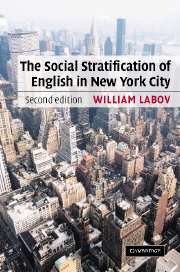Book contents
- Frontmatter
- Contents
- Introductory note
- Preface to the first edition
- Preface to the second edition: forty years later
- I Problems and methods of analysis
- II Social differentiation
- III Social evaluation
- IV Synthesis
- Glossary of linguistic symbols and terminology
- Appendix A Questionnaire for the ALS Survey
- Appendix B Anonymous observations of casual speech
- Appendix C Analysis of losses through moving of the MFY sample population
- Appendix D Analysis of the non-respondents: the television interview
- Appendix E The out-of-town speakers
- Bibliography
- Index
Appendix C - Analysis of losses through moving of the MFY sample population
Published online by Cambridge University Press: 18 December 2009
- Frontmatter
- Contents
- Introductory note
- Preface to the first edition
- Preface to the second edition: forty years later
- I Problems and methods of analysis
- II Social differentiation
- III Social evaluation
- IV Synthesis
- Glossary of linguistic symbols and terminology
- Appendix A Questionnaire for the ALS Survey
- Appendix B Anonymous observations of casual speech
- Appendix C Analysis of losses through moving of the MFY sample population
- Appendix D Analysis of the non-respondents: the television interview
- Appendix E The out-of-town speakers
- Bibliography
- Index
Summary
This discussion is an analysis of the type of losses sustained by the original Mobilization for Youth (MFY) sample population through moving in the two-year period between the MFY survey and the American Language Survey (ALS). The sample population of native English speakers which was selected for study consisted of 312 individuals. Eight of these died, or became incapacitated, and 109 moved, leaving the ALS target sample of 195 subjects. By analyzing the social characteristics of the group who moved, we will be able to determine in what way the ALS target sample does or does not represent the original population of native speakers present on the Lower East Side in 1961.
The distribution of speakers who had moved or died, according to racial and ethnic group, may be seen in Table C.1.
The only serious discrepancy here is with the Protestant group, which shows twice as high a rate of moving as the others. This is what we would expect from the rootless concern. It appears that not more than one or two of the sixteen who had moved were natives of New York City, and therefore would in any case not have appeared in the most important of the studies to follow Chapter 6.
The other groups are approximately the same as far as rate of moving is concerned, with the Catholics showing a somewhat higher figure.
- Type
- Chapter
- Information
- The Social Stratification of English in New York City , pp. 430 - 436Publisher: Cambridge University PressPrint publication year: 2006



